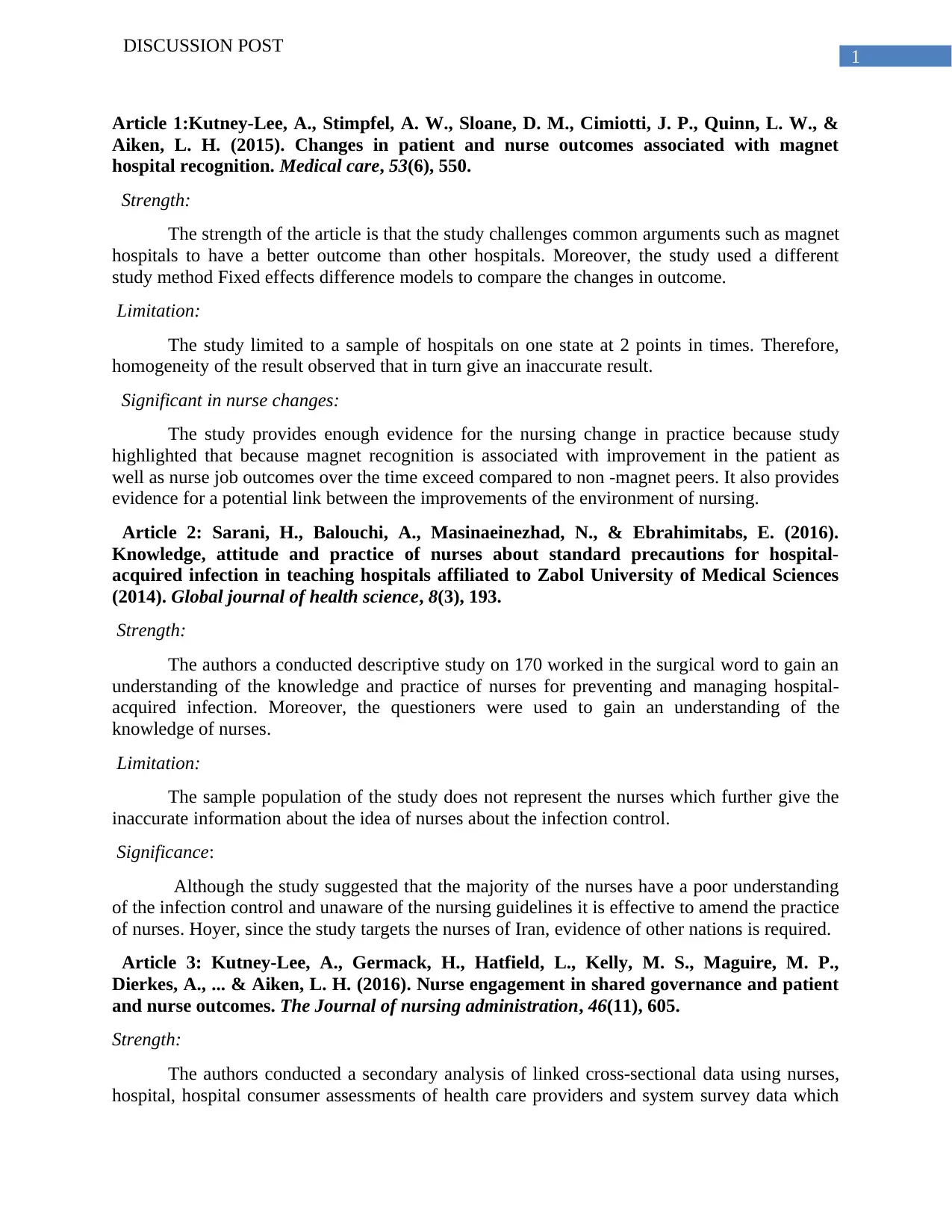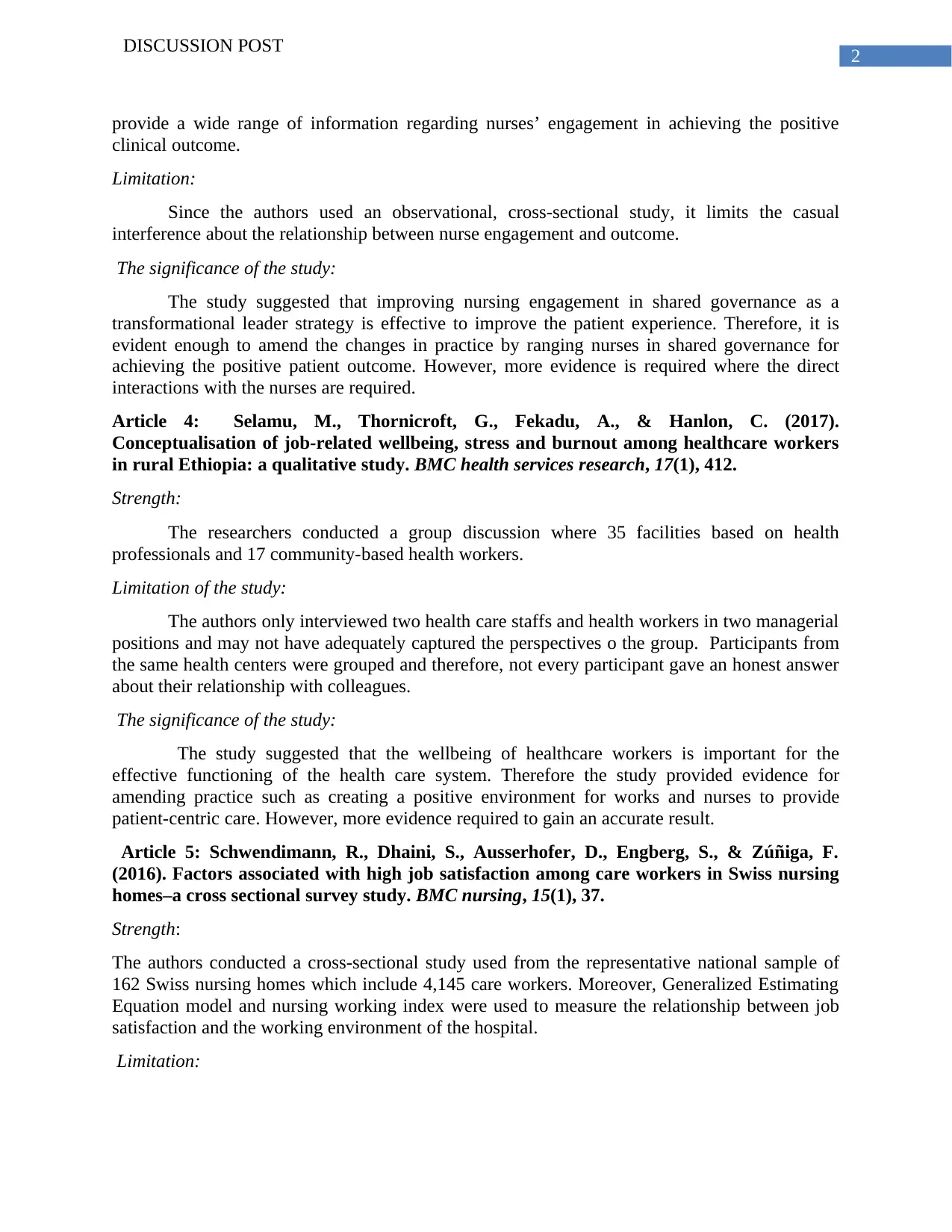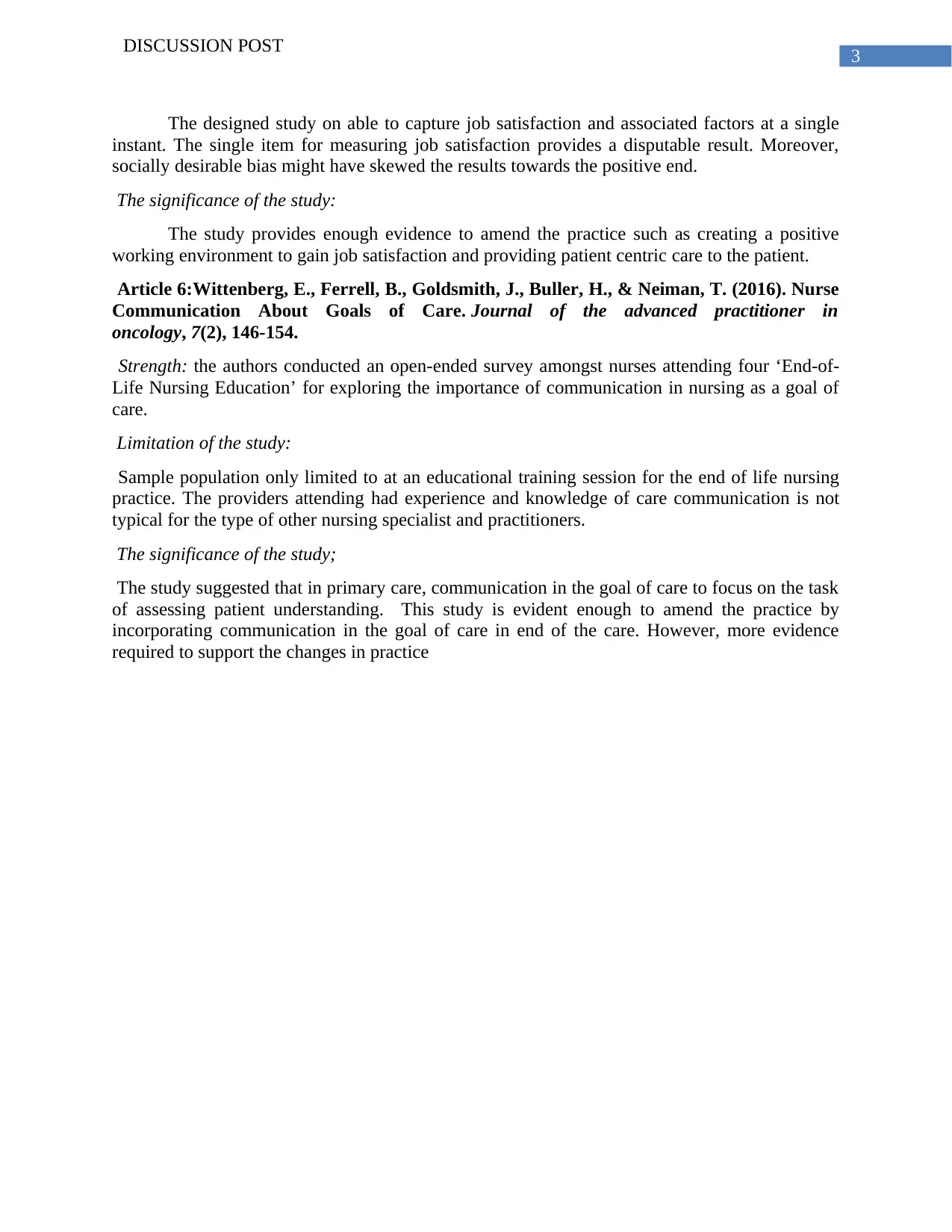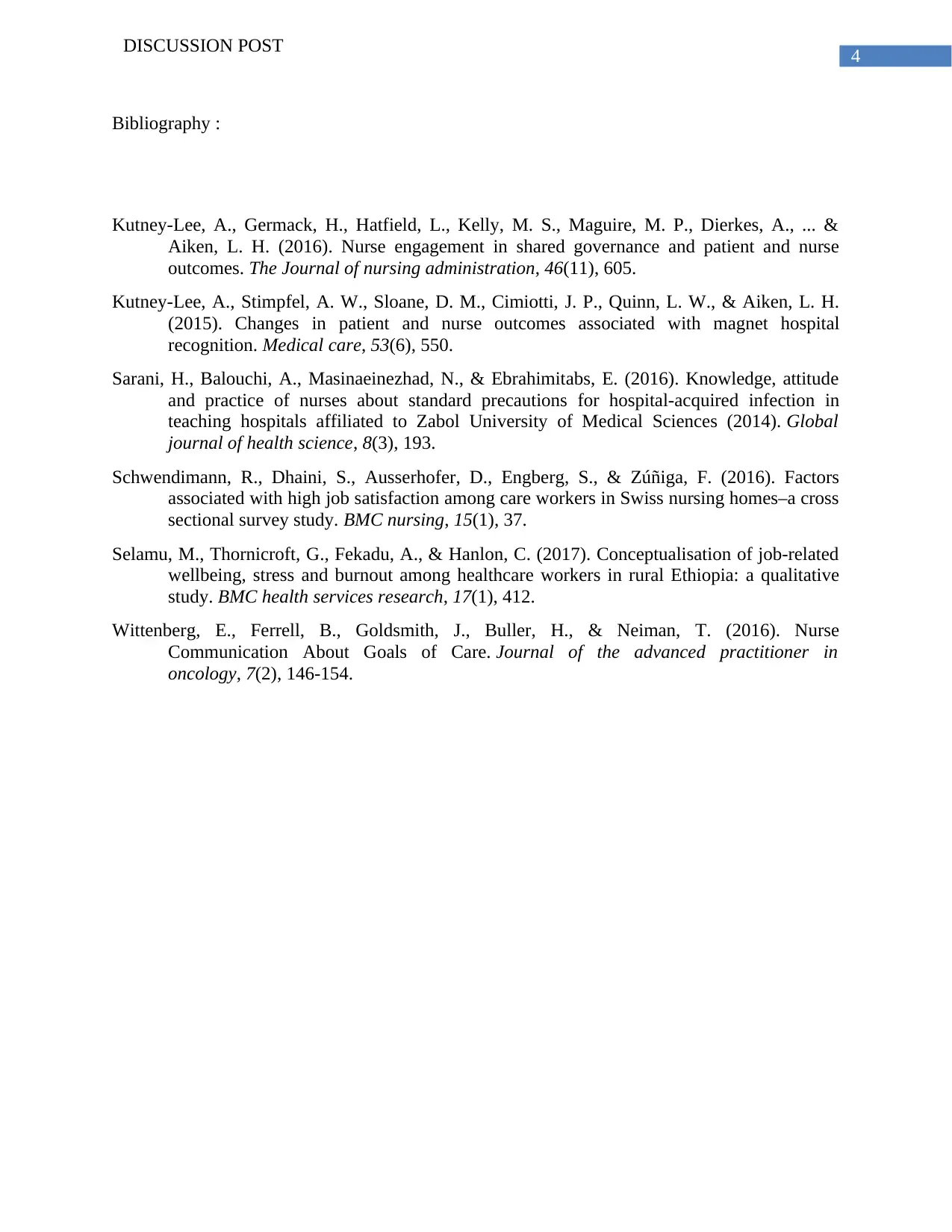Analysis of Nursing Practice: A Critical Discussion Post on Articles
VerifiedAdded on 2023/04/21
|5
|1528
|293
Discussion Board Post
AI Summary
This discussion post presents a critical analysis of six articles focusing on various aspects of nursing practice and healthcare outcomes. The analysis covers the strengths, limitations, and significance of each study in amending nursing practices. Key topics include the impact of magnet hospital recognition on patient and nurse outcomes, nurses' knowledge and practice regarding hospital-acquired infections, the effect of nurse engagement in shared governance, healthcare worker well-being in rural Ethiopia, factors influencing job satisfaction among care workers in Swiss nursing homes, and the importance of nurse communication about goals of care. Each article's potential to inform and improve nursing practice is evaluated, highlighting the need for further research and evidence to support changes in healthcare settings. Desklib provides access to similar solved assignments and resources for students.

Running head : DISCUSSION POST
Name of the student:
Name of the university:
Author note:
Name of the student:
Name of the university:
Author note:
Paraphrase This Document
Need a fresh take? Get an instant paraphrase of this document with our AI Paraphraser

1
DISCUSSION POST
Article 1:Kutney-Lee, A., Stimpfel, A. W., Sloane, D. M., Cimiotti, J. P., Quinn, L. W., &
Aiken, L. H. (2015). Changes in patient and nurse outcomes associated with magnet
hospital recognition. Medical care, 53(6), 550.
Strength:
The strength of the article is that the study challenges common arguments such as magnet
hospitals to have a better outcome than other hospitals. Moreover, the study used a different
study method Fixed effects difference models to compare the changes in outcome.
Limitation:
The study limited to a sample of hospitals on one state at 2 points in times. Therefore,
homogeneity of the result observed that in turn give an inaccurate result.
Significant in nurse changes:
The study provides enough evidence for the nursing change in practice because study
highlighted that because magnet recognition is associated with improvement in the patient as
well as nurse job outcomes over the time exceed compared to non -magnet peers. It also provides
evidence for a potential link between the improvements of the environment of nursing.
Article 2: Sarani, H., Balouchi, A., Masinaeinezhad, N., & Ebrahimitabs, E. (2016).
Knowledge, attitude and practice of nurses about standard precautions for hospital-
acquired infection in teaching hospitals affiliated to Zabol University of Medical Sciences
(2014). Global journal of health science, 8(3), 193.
Strength:
The authors a conducted descriptive study on 170 worked in the surgical word to gain an
understanding of the knowledge and practice of nurses for preventing and managing hospital-
acquired infection. Moreover, the questioners were used to gain an understanding of the
knowledge of nurses.
Limitation:
The sample population of the study does not represent the nurses which further give the
inaccurate information about the idea of nurses about the infection control.
Significance:
Although the study suggested that the majority of the nurses have a poor understanding
of the infection control and unaware of the nursing guidelines it is effective to amend the practice
of nurses. Hoyer, since the study targets the nurses of Iran, evidence of other nations is required.
Article 3: Kutney-Lee, A., Germack, H., Hatfield, L., Kelly, M. S., Maguire, M. P.,
Dierkes, A., ... & Aiken, L. H. (2016). Nurse engagement in shared governance and patient
and nurse outcomes. The Journal of nursing administration, 46(11), 605.
Strength:
The authors conducted a secondary analysis of linked cross-sectional data using nurses,
hospital, hospital consumer assessments of health care providers and system survey data which
DISCUSSION POST
Article 1:Kutney-Lee, A., Stimpfel, A. W., Sloane, D. M., Cimiotti, J. P., Quinn, L. W., &
Aiken, L. H. (2015). Changes in patient and nurse outcomes associated with magnet
hospital recognition. Medical care, 53(6), 550.
Strength:
The strength of the article is that the study challenges common arguments such as magnet
hospitals to have a better outcome than other hospitals. Moreover, the study used a different
study method Fixed effects difference models to compare the changes in outcome.
Limitation:
The study limited to a sample of hospitals on one state at 2 points in times. Therefore,
homogeneity of the result observed that in turn give an inaccurate result.
Significant in nurse changes:
The study provides enough evidence for the nursing change in practice because study
highlighted that because magnet recognition is associated with improvement in the patient as
well as nurse job outcomes over the time exceed compared to non -magnet peers. It also provides
evidence for a potential link between the improvements of the environment of nursing.
Article 2: Sarani, H., Balouchi, A., Masinaeinezhad, N., & Ebrahimitabs, E. (2016).
Knowledge, attitude and practice of nurses about standard precautions for hospital-
acquired infection in teaching hospitals affiliated to Zabol University of Medical Sciences
(2014). Global journal of health science, 8(3), 193.
Strength:
The authors a conducted descriptive study on 170 worked in the surgical word to gain an
understanding of the knowledge and practice of nurses for preventing and managing hospital-
acquired infection. Moreover, the questioners were used to gain an understanding of the
knowledge of nurses.
Limitation:
The sample population of the study does not represent the nurses which further give the
inaccurate information about the idea of nurses about the infection control.
Significance:
Although the study suggested that the majority of the nurses have a poor understanding
of the infection control and unaware of the nursing guidelines it is effective to amend the practice
of nurses. Hoyer, since the study targets the nurses of Iran, evidence of other nations is required.
Article 3: Kutney-Lee, A., Germack, H., Hatfield, L., Kelly, M. S., Maguire, M. P.,
Dierkes, A., ... & Aiken, L. H. (2016). Nurse engagement in shared governance and patient
and nurse outcomes. The Journal of nursing administration, 46(11), 605.
Strength:
The authors conducted a secondary analysis of linked cross-sectional data using nurses,
hospital, hospital consumer assessments of health care providers and system survey data which

2
DISCUSSION POST
provide a wide range of information regarding nurses’ engagement in achieving the positive
clinical outcome.
Limitation:
Since the authors used an observational, cross-sectional study, it limits the casual
interference about the relationship between nurse engagement and outcome.
The significance of the study:
The study suggested that improving nursing engagement in shared governance as a
transformational leader strategy is effective to improve the patient experience. Therefore, it is
evident enough to amend the changes in practice by ranging nurses in shared governance for
achieving the positive patient outcome. However, more evidence is required where the direct
interactions with the nurses are required.
Article 4: Selamu, M., Thornicroft, G., Fekadu, A., & Hanlon, C. (2017).
Conceptualisation of job-related wellbeing, stress and burnout among healthcare workers
in rural Ethiopia: a qualitative study. BMC health services research, 17(1), 412.
Strength:
The researchers conducted a group discussion where 35 facilities based on health
professionals and 17 community-based health workers.
Limitation of the study:
The authors only interviewed two health care staffs and health workers in two managerial
positions and may not have adequately captured the perspectives o the group. Participants from
the same health centers were grouped and therefore, not every participant gave an honest answer
about their relationship with colleagues.
The significance of the study:
The study suggested that the wellbeing of healthcare workers is important for the
effective functioning of the health care system. Therefore the study provided evidence for
amending practice such as creating a positive environment for works and nurses to provide
patient-centric care. However, more evidence required to gain an accurate result.
Article 5: Schwendimann, R., Dhaini, S., Ausserhofer, D., Engberg, S., & Zúñiga, F.
(2016). Factors associated with high job satisfaction among care workers in Swiss nursing
homes–a cross sectional survey study. BMC nursing, 15(1), 37.
Strength:
The authors conducted a cross-sectional study used from the representative national sample of
162 Swiss nursing homes which include 4,145 care workers. Moreover, Generalized Estimating
Equation model and nursing working index were used to measure the relationship between job
satisfaction and the working environment of the hospital.
Limitation:
DISCUSSION POST
provide a wide range of information regarding nurses’ engagement in achieving the positive
clinical outcome.
Limitation:
Since the authors used an observational, cross-sectional study, it limits the casual
interference about the relationship between nurse engagement and outcome.
The significance of the study:
The study suggested that improving nursing engagement in shared governance as a
transformational leader strategy is effective to improve the patient experience. Therefore, it is
evident enough to amend the changes in practice by ranging nurses in shared governance for
achieving the positive patient outcome. However, more evidence is required where the direct
interactions with the nurses are required.
Article 4: Selamu, M., Thornicroft, G., Fekadu, A., & Hanlon, C. (2017).
Conceptualisation of job-related wellbeing, stress and burnout among healthcare workers
in rural Ethiopia: a qualitative study. BMC health services research, 17(1), 412.
Strength:
The researchers conducted a group discussion where 35 facilities based on health
professionals and 17 community-based health workers.
Limitation of the study:
The authors only interviewed two health care staffs and health workers in two managerial
positions and may not have adequately captured the perspectives o the group. Participants from
the same health centers were grouped and therefore, not every participant gave an honest answer
about their relationship with colleagues.
The significance of the study:
The study suggested that the wellbeing of healthcare workers is important for the
effective functioning of the health care system. Therefore the study provided evidence for
amending practice such as creating a positive environment for works and nurses to provide
patient-centric care. However, more evidence required to gain an accurate result.
Article 5: Schwendimann, R., Dhaini, S., Ausserhofer, D., Engberg, S., & Zúñiga, F.
(2016). Factors associated with high job satisfaction among care workers in Swiss nursing
homes–a cross sectional survey study. BMC nursing, 15(1), 37.
Strength:
The authors conducted a cross-sectional study used from the representative national sample of
162 Swiss nursing homes which include 4,145 care workers. Moreover, Generalized Estimating
Equation model and nursing working index were used to measure the relationship between job
satisfaction and the working environment of the hospital.
Limitation:
⊘ This is a preview!⊘
Do you want full access?
Subscribe today to unlock all pages.

Trusted by 1+ million students worldwide

3
DISCUSSION POST
The designed study on able to capture job satisfaction and associated factors at a single
instant. The single item for measuring job satisfaction provides a disputable result. Moreover,
socially desirable bias might have skewed the results towards the positive end.
The significance of the study:
The study provides enough evidence to amend the practice such as creating a positive
working environment to gain job satisfaction and providing patient centric care to the patient.
Article 6:Wittenberg, E., Ferrell, B., Goldsmith, J., Buller, H., & Neiman, T. (2016). Nurse
Communication About Goals of Care. Journal of the advanced practitioner in
oncology, 7(2), 146-154.
Strength: the authors conducted an open-ended survey amongst nurses attending four ‘End-of-
Life Nursing Education’ for exploring the importance of communication in nursing as a goal of
care.
Limitation of the study:
Sample population only limited to at an educational training session for the end of life nursing
practice. The providers attending had experience and knowledge of care communication is not
typical for the type of other nursing specialist and practitioners.
The significance of the study;
The study suggested that in primary care, communication in the goal of care to focus on the task
of assessing patient understanding. This study is evident enough to amend the practice by
incorporating communication in the goal of care in end of the care. However, more evidence
required to support the changes in practice
DISCUSSION POST
The designed study on able to capture job satisfaction and associated factors at a single
instant. The single item for measuring job satisfaction provides a disputable result. Moreover,
socially desirable bias might have skewed the results towards the positive end.
The significance of the study:
The study provides enough evidence to amend the practice such as creating a positive
working environment to gain job satisfaction and providing patient centric care to the patient.
Article 6:Wittenberg, E., Ferrell, B., Goldsmith, J., Buller, H., & Neiman, T. (2016). Nurse
Communication About Goals of Care. Journal of the advanced practitioner in
oncology, 7(2), 146-154.
Strength: the authors conducted an open-ended survey amongst nurses attending four ‘End-of-
Life Nursing Education’ for exploring the importance of communication in nursing as a goal of
care.
Limitation of the study:
Sample population only limited to at an educational training session for the end of life nursing
practice. The providers attending had experience and knowledge of care communication is not
typical for the type of other nursing specialist and practitioners.
The significance of the study;
The study suggested that in primary care, communication in the goal of care to focus on the task
of assessing patient understanding. This study is evident enough to amend the practice by
incorporating communication in the goal of care in end of the care. However, more evidence
required to support the changes in practice
Paraphrase This Document
Need a fresh take? Get an instant paraphrase of this document with our AI Paraphraser

4
DISCUSSION POST
Bibliography :
Kutney-Lee, A., Germack, H., Hatfield, L., Kelly, M. S., Maguire, M. P., Dierkes, A., ... &
Aiken, L. H. (2016). Nurse engagement in shared governance and patient and nurse
outcomes. The Journal of nursing administration, 46(11), 605.
Kutney-Lee, A., Stimpfel, A. W., Sloane, D. M., Cimiotti, J. P., Quinn, L. W., & Aiken, L. H.
(2015). Changes in patient and nurse outcomes associated with magnet hospital
recognition. Medical care, 53(6), 550.
Sarani, H., Balouchi, A., Masinaeinezhad, N., & Ebrahimitabs, E. (2016). Knowledge, attitude
and practice of nurses about standard precautions for hospital-acquired infection in
teaching hospitals affiliated to Zabol University of Medical Sciences (2014). Global
journal of health science, 8(3), 193.
Schwendimann, R., Dhaini, S., Ausserhofer, D., Engberg, S., & Zúñiga, F. (2016). Factors
associated with high job satisfaction among care workers in Swiss nursing homes–a cross
sectional survey study. BMC nursing, 15(1), 37.
Selamu, M., Thornicroft, G., Fekadu, A., & Hanlon, C. (2017). Conceptualisation of job-related
wellbeing, stress and burnout among healthcare workers in rural Ethiopia: a qualitative
study. BMC health services research, 17(1), 412.
Wittenberg, E., Ferrell, B., Goldsmith, J., Buller, H., & Neiman, T. (2016). Nurse
Communication About Goals of Care. Journal of the advanced practitioner in
oncology, 7(2), 146-154.
DISCUSSION POST
Bibliography :
Kutney-Lee, A., Germack, H., Hatfield, L., Kelly, M. S., Maguire, M. P., Dierkes, A., ... &
Aiken, L. H. (2016). Nurse engagement in shared governance and patient and nurse
outcomes. The Journal of nursing administration, 46(11), 605.
Kutney-Lee, A., Stimpfel, A. W., Sloane, D. M., Cimiotti, J. P., Quinn, L. W., & Aiken, L. H.
(2015). Changes in patient and nurse outcomes associated with magnet hospital
recognition. Medical care, 53(6), 550.
Sarani, H., Balouchi, A., Masinaeinezhad, N., & Ebrahimitabs, E. (2016). Knowledge, attitude
and practice of nurses about standard precautions for hospital-acquired infection in
teaching hospitals affiliated to Zabol University of Medical Sciences (2014). Global
journal of health science, 8(3), 193.
Schwendimann, R., Dhaini, S., Ausserhofer, D., Engberg, S., & Zúñiga, F. (2016). Factors
associated with high job satisfaction among care workers in Swiss nursing homes–a cross
sectional survey study. BMC nursing, 15(1), 37.
Selamu, M., Thornicroft, G., Fekadu, A., & Hanlon, C. (2017). Conceptualisation of job-related
wellbeing, stress and burnout among healthcare workers in rural Ethiopia: a qualitative
study. BMC health services research, 17(1), 412.
Wittenberg, E., Ferrell, B., Goldsmith, J., Buller, H., & Neiman, T. (2016). Nurse
Communication About Goals of Care. Journal of the advanced practitioner in
oncology, 7(2), 146-154.
1 out of 5
Related Documents
Your All-in-One AI-Powered Toolkit for Academic Success.
+13062052269
info@desklib.com
Available 24*7 on WhatsApp / Email
![[object Object]](/_next/static/media/star-bottom.7253800d.svg)
Unlock your academic potential
Copyright © 2020–2025 A2Z Services. All Rights Reserved. Developed and managed by ZUCOL.





